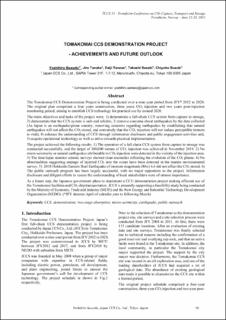| dc.description.abstract | The Tomakomai CCS Demonstration Project is being conducted over a nine-year period from JFY* 2012 to 2020. The original plan comprised a four years construction, three years CO2 injection and two years post-injection monitoring period, aiming to establish CCS technology for practical use by around 2020.
The main objectives and tasks of the project were; 1) demonstrate a full-chain CCS system from capture to storage, 2) demonstrate that the CCS system is safe and reliable, 3) remove concerns about earthquakes by the data collected (As Japan is an earthquake-prone country, removing concerns regarding earthquakes by establishing that natural earthquakes will not affect the CO2 stored, and conversely that the CO2 injection will not induce perceptible tremors is vital), 4) enhance the understanding of CCS through information disclosure and public engagement activities and, 5) acquire operational technology as well as strive towards practical implementation.
The project achieved the following results. 1) The operation of a full chain CCS system from capture to storage was conducted successfully, and the target of 300,000 tonnes of CO2 injection was achieved in November 2019. 2) No micro-seismicity or natural earthquakes attributable to CO2 injection were detected in the vicinity of the injection area. 3) The time-lapse monitor seismic surveys showed clear anomalies reflecting the evolution of the CO2 plume. 4) No abnormalities suggesting seepage of injected CO2 into the ocean have been detected in the marine environmental survey. 5) 2018 Hokkaido Eastern Iburi Earthquake of moment magnitude (Mw) 6.6 did not affect the CO2 stored. 6) The public outreach program has been largely successful, with no major opposition to the project. Information disclosure and diligent efforts to secure the understanding of local stakeholders were of utmost importance.
As a future step, the Japanese government plans to implement a CCU demonstration project making efficient use of the Tomakomai facilities and CO2 ship transportation. JCCS is presently supporting a feasibility study being conducted by the Ministry of Economy, Trade and Industry (METI) and the New Energy and Industrial Technology Development Organization (NEDO). (*JFY denotes April of calendar year to following March) | en_US |

